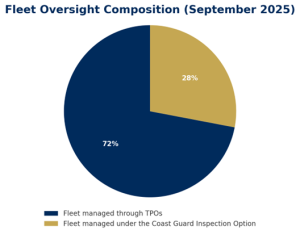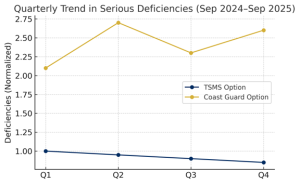Spotlight: Jo Ann Campbell, Owner of Salyers Solutions
Spotlight: Jo Ann Campbell, Owner of Salyers Solutions
Gaining an Auditor’s Perspective: How TVIB’s Subchapter M Auditor Course Strengthened a Consultant’s Approach


TVIB’s Subchapter M Auditor Course is designed to equip maritime professionals with the knowledge, skills, and tools to conduct both management and vessel audits in accordance with 46 CFR Subchapter M. The training combines classroom instruction with practical exercises, real-world case studies, and peer discussion to ensure participants leave confident in their understanding of audit principles, documentation, and field application.
Whether attendees are new to auditing or experienced in compliance and safety management, the course provides a comprehensive foundation for those pursuing TVIB Auditor Certification or seeking to strengthen their organization’s safety management system.
In this participant spotlight, TVIB is featuring Jo Ann Campbell, Owner and Consultant at Salyers Solutions, a maritime compliance and safety consulting firm.
Jo Ann recently attended TVIB’s Subchapter M Auditor Course at our training facility in Houston, Texas. With her deep experience supporting towing vessel operators, when asked why she joined the course she mentioned, “As an experienced auditor who attended one of TVIB’s first Subchapter M training sessions, I wanted to see how the course has evolved.”
She found that the updated course offered a clear, methodical path for both new and experienced auditors alike. “The course structure paved the walkway starting from the foundation of being an auditor to the steps needed to perform and complete an audit. The overall learning environment was excellent, from the visual presentation to the hands-on group exercises. The instructor allowed time for discussions and ‘sea stories’ while maintaining the flow of the course.”
Although she initially intended to observe quietly, Jo Ann quickly found herself back in the role of a full participant, “No such luck,” she laughed. “I was placed in the class as a participant and was involved in all aspects of the training. It ended up being a great refresher.”
She walked away with two major reminders that shape every audit she conducts:
- Every audit requires the full process. “Even though I work with many of the same companies, each audit must follow all steps—especially developing a fresh audit plan for each job.”
- Words matter. “When writing findings, the reader—whether TPO, USCG, or client—needs to visualize what you’re describing as if they were onboard or reviewing the TSMS.”
Working independently as a consultant, Jo Ann particularly valued the group interaction and collaboration the course encouraged. “Because I work for myself, I don’t have much interaction with other auditors. The group exercises and discussions gave me new perspectives and put me back on track to the basics of the auditing process.”
For those considering the course, Jo Ann offers clear advice:
“Whether this is the career path you’re pursuing, or your company simply wants a deeper understanding of the external auditor’s role, this course provides an excellent foundation and the confidence to perform and participate in audits effectively.”
Jo Ann also credits the TVIB training team and support staff for creating an environment of professionalism and guidance. “Having instructors like Tava, Caleb, and Ken—who all have maritime backgrounds—is invaluable. They bring real-world insight to every discussion. And the support staff keeps the entire process running smoothly.”
For Jo Ann, the TVIB Subchapter M Auditor Course served as both a technical refresher and a professional reset. It reaffirmed that even the most experienced auditors benefit from revisiting the fundamentals—ensuring every audit is approached with clarity, precision, and a fresh perspective.
Jo Ann’s experience reflects how TVIB’s training programs help professionals across the towing industry gain the skills and confidence needed to promote safe, compliant operations.
Our Subchapter M Auditor Course continues to equip participants with practical auditing tools, deeper understanding of regulatory expectations, and the ability to contribute meaningfully to their organizations’ safety management systems.
About Jo Ann Campbell
Jo Ann Campbell is the Owner and Consultant at Salyers Solutions, where she provides safety, compliance, and operational consulting services to towing vessel operators and maritime organizations. Drawing on decades of industry experience, Jo Ann partners with companies to strengthen their management systems, prepare for audits, and foster a proactive culture of compliance and safety. She is also a TPO Sub M Auditor and external surveyor.


